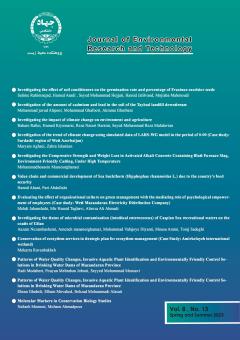-
-
-
Open Access Article
1 - The Investigation of Ability to Degradation and Removal of Various Dyes Using Silver Colloidal Nanoparticles
Mohadeseh Tavakoli Fariba OstovarColors are one of the most important pollutants of water, and only one entry into the water can significantly reduce the quality of water. In addition, due to the synthetic origin and the presence of complex molecules in the structure of colors, the purification process MoreColors are one of the most important pollutants of water, and only one entry into the water can significantly reduce the quality of water. In addition, due to the synthetic origin and the presence of complex molecules in the structure of colors, the purification process is sometimes accompanied by some problems. Colloidal nanoparticles play an important role in technology, especially in the manufacture of glass and ceramics, and are used as a suitable method for cleaning pollutants in water and wastewater. In this study, a chemical regeneration method was used to synthesize colloidal silver nanoparticles. Then, to evaluate the efficiency of synthetic silver nanoparticles, several solutions of dye and pigments such as sulfur, azo, reactive, cationic and anionic dyes were prepared and synthetic material was used for degradation of different colors. Finally, the effect of this colloidal nanoparticle on each of them was studied and compared. The results showed that silver colloidal nanoparticles have the ability to degradation and removal of methyl orange and methyl red dyes from aqueous samples, and these nanoparticles can be used for treatment the water and wastewater containing these dyes. Manuscript profile -
Open Access Article
2 - Evaluation of natural adsorbents in water and wastewater treatment
Mohadeseh TavakoliWith increasing industrial activities and discharging untreated wastewater which contains various environmental pollutants to aquatic environments, problems such as reducing the penetration of light, anaerobic conditions and complications such as allergies and cancer fo MoreWith increasing industrial activities and discharging untreated wastewater which contains various environmental pollutants to aquatic environments, problems such as reducing the penetration of light, anaerobic conditions and complications such as allergies and cancer for humans and other living organisms will occur. Surface absorption is one of the most effective and efficient methods for the removal of environmental pollutants and among the common methods for treatment of wastewater, applying natural adsorbents are more efficient than the other methods and is more economic. Since there are many natural adsorbents in nature, they are very inexpensive, they are even free in some cases; adsorption of contaminants by these materials can be a suitable way to remove the toxic substances of contaminated water and industrial wastewater. In this paper, we study some of bioactive adsorbents in order to remove contamination from industrial wastewater. Manuscript profile -
Open Access Article
3 - Investigation of Congored dye removal from industrial waste water using adsorption method
Mohadeseh Tavakoli niloofar AbedinzadeThese days, the removal of various dyes from industrial wastewater has become an important concern. Synthetic dyes used in industries such as textiles are complex, toxic and mutant organic materials. Congored is also an acidic dye that is considered a high- risk source MoreThese days, the removal of various dyes from industrial wastewater has become an important concern. Synthetic dyes used in industries such as textiles are complex, toxic and mutant organic materials. Congored is also an acidic dye that is considered a high- risk source of contamination and threatens the lives of humans and other living organisms. Different methods, such as electrochemical, physical and biological processes, are used to remove organic pigment from aqueous samples. Adsorption is one of the most effective modern methods of industrial wastewater treatment, which is a relatively simple and inexpensive process that produces non- toxic and low- risk products. The purpose of this study is removing the Congored dye from aqueous solutions and reviewing the accomplished researches for remove it. Manuscript profile
List of Articles Mohadese Tavakoli
-
The rights to this website are owned by the Raimag Press Management System.
Copyright © 2017-2024


